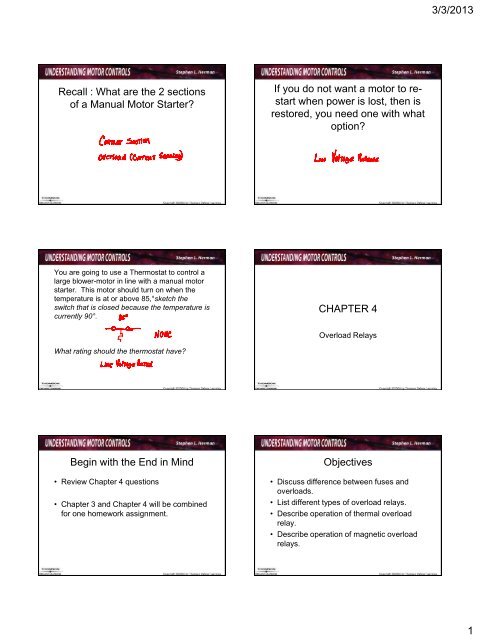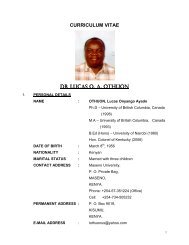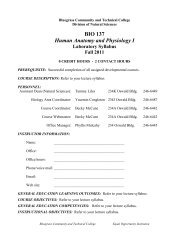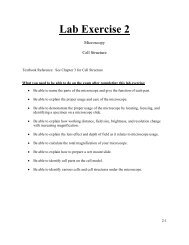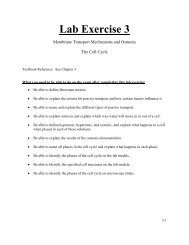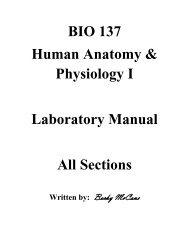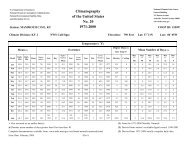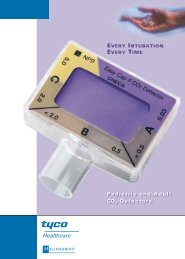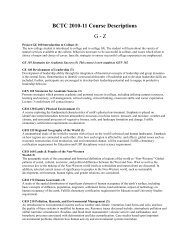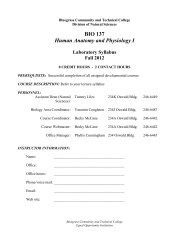If you do not want a motor to re- start when power is lost, then is
If you do not want a motor to re- start when power is lost, then is
If you do not want a motor to re- start when power is lost, then is
You also want an ePaper? Increase the reach of your titles
YUMPU automatically turns print PDFs into web optimized ePapers that Google loves.
Recall : What a<strong>re</strong> the 2 sections<br />
of a Manual Mo<strong>to</strong>r Starter?<br />
You a<strong>re</strong> going <strong>to</strong> use a Thermostat <strong>to</strong> control a<br />
large blower-<strong>mo<strong>to</strong>r</strong> in line with a manual <strong>mo<strong>to</strong>r</strong><br />
<strong>start</strong>er. Th<strong>is</strong> <strong>mo<strong>to</strong>r</strong> should turn on <strong>when</strong> the<br />
temperatu<strong>re</strong> <strong>is</strong> at or above 85,°sketch the<br />
switch that <strong>is</strong> closed because the temperatu<strong>re</strong> <strong>is</strong><br />
cur<strong>re</strong>ntly 90°.<br />
What rating should the thermostat have?<br />
Begin with the End in Mind<br />
• Review Chapter 4 questions<br />
• Chapter 3 and Chapter 4 will be combined<br />
for one homework assignment.<br />
<strong>If</strong> <strong>you</strong> <strong>do</strong> <strong>not</strong> <strong>want</strong> a <strong>mo<strong>to</strong>r</strong> <strong>to</strong> <strong>re</strong><strong>start</strong><br />
<strong>when</strong> <strong>power</strong> <strong>is</strong> <strong>lost</strong>, <strong>then</strong> <strong>is</strong><br />
<strong>re</strong>s<strong>to</strong><strong>re</strong>d, <strong>you</strong> need one with what<br />
option?<br />
CHAPTER 4<br />
Overload Relays<br />
Objectives<br />
• D<strong>is</strong>cuss diffe<strong>re</strong>nce between fuses and<br />
overloads.<br />
• L<strong>is</strong>t diffe<strong>re</strong>nt types of overload <strong>re</strong>lays.<br />
• Describe operation of thermal overload<br />
<strong>re</strong>lay.<br />
• Describe operation of magnetic overload<br />
<strong>re</strong>lays.<br />
3/3/2013<br />
1
Fuses/ Circuit B<strong>re</strong>akers (1 of 2)<br />
• Diffe<strong>re</strong>nce between fuse/circuit b<strong>re</strong>aker<br />
protection and overload protection:<br />
– Fuses (with the exception of dual element time<br />
delay types) and circuit b<strong>re</strong>akers protect circuit<br />
from grounds and short circuits only.<br />
– Protect Mo<strong>to</strong>r Circuit and Power system from a<br />
short in the <strong>mo<strong>to</strong>r</strong> circuit.<br />
– C.B.’s a<strong>re</strong> mo<strong>re</strong> expensive but can be <strong>re</strong>set, Fuses<br />
a<strong>re</strong> less expensive but can be <strong>re</strong>al pain <strong>to</strong> <strong>re</strong>place.<br />
Overload Relays (2 of 2)<br />
• A fuse or circuit b<strong>re</strong>aker <strong>do</strong>es <strong>not</strong> protect<br />
the <strong>mo<strong>to</strong>r</strong> from an overload.<br />
Dual Element Fuses<br />
• They provide both short circuit and overcur<strong>re</strong>nt<br />
protection.<br />
• Fuse link provides short circuit protection.<br />
• Solder link provides over-cur<strong>re</strong>nt<br />
protection with time delay.<br />
• Work well, a<strong>re</strong> cheaper than Resetable<br />
types, but can<strong>not</strong> be <strong>re</strong>set<br />
Overloads (1 of 2)<br />
• Overload protection provides protection <strong>to</strong> the<br />
<strong>mo<strong>to</strong>r</strong> from overload conditions (excessive<br />
cur<strong>re</strong>nt through the <strong>mo<strong>to</strong>r</strong> windings).<br />
– “Protect against a little <strong>to</strong>o much cur<strong>re</strong>nt for a little<br />
<strong>to</strong>o long”<br />
• “A little <strong>to</strong>o much Cur<strong>re</strong>nt” <strong>is</strong> typically 125% Name-plate<br />
• “A little <strong>to</strong>o long” <strong>is</strong> typically 2 minutes<br />
Overload Properties<br />
• Must have means of sensing <strong>mo<strong>to</strong>r</strong> cur<strong>re</strong>nt<br />
• Must have some type of time delay<br />
• Two operating sections<br />
– Cur<strong>re</strong>nt sensing and contact section<br />
Cur<strong>re</strong>nt<br />
Sensor in<br />
Mo<strong>to</strong>r<br />
Circuit<br />
OL Contacts<br />
in Control<br />
Circuit<br />
2 Categories of OL Relays<br />
1) Thermal<br />
Responds <strong>to</strong> the Heat due <strong>to</strong> Cur<strong>re</strong>nt<br />
Flow<br />
2) Magnetic<br />
Responds <strong>to</strong> the Magnetic field due <strong>to</strong><br />
Cur<strong>re</strong>nt Flow<br />
3/3/2013<br />
2
Thermal Overload Relays<br />
• Thermal overload <strong>re</strong>lays<br />
• Both may use the same symbol on a<br />
drawing<br />
• Two types<br />
– Solder pot<br />
– Bimetal strip<br />
Thermal Overload Relays (2 of 5)<br />
• The spring pushes the contact open <strong>when</strong> heat melts<br />
alloy causing the ratchet wheel <strong>to</strong> turn.<br />
Thermal Overload Relays (1 of 5)<br />
• Solder pot<br />
Thermal Overload Relays (3 of 6)<br />
Thermal Overload Relays (4 of 6) Thermal Overload Relays (6 of 6)<br />
• Bimetal strip<br />
– Same principle as melting alloy-type, but<br />
uses metal strip <strong>to</strong> sense heat rather than<br />
melting alloy<br />
3/3/2013<br />
3
•<br />
Bimetal Strip<br />
Overload Relays<br />
Note that Bi-Metalic OLs can<br />
be adjusted.<br />
A Solder-Pot Ol only works for<br />
one cur<strong>re</strong>nt level.<br />
Th<strong>re</strong>e-phase Overloads (2 of 2)<br />
Bimetal Strip Relay<br />
Th<strong>re</strong>e-phase Overloads (1 of 2)<br />
• Th<strong>re</strong>e-phase overload <strong>re</strong>lays a<strong>re</strong> used <strong>to</strong><br />
sense the cur<strong>re</strong>nt in each of the th<strong>re</strong>e<br />
phase lines.<br />
Single-phase Overload<br />
• Control circuit<br />
3/3/2013<br />
4
Th<strong>re</strong>e-phase Overloads (1 of 2)<br />
• Control circuit (Th<strong>is</strong> OL has 3 separate contacts)<br />
Magnetic Overload Relays<br />
• Two types<br />
– Elelctronic<br />
– Dashpot<br />
Electronic OLR<br />
Th<strong>is</strong> <strong>do</strong>es a Whole<br />
lot mo<strong>re</strong> than<br />
simply open the<br />
circuit if the<br />
cur<strong>re</strong>nt a bit <strong>to</strong>o<br />
high for a bit <strong>to</strong>o<br />
long! Click-it for<br />
mo<strong>re</strong> information.<br />
Th<strong>re</strong>e-phase Overloads (2 of 2)<br />
• Control circuit (Th<strong>is</strong> OL has one contact)<br />
Magnetic Overload<br />
Relays Electronic (1 of 2)<br />
• Use cur<strong>re</strong>nt transformers <strong>to</strong> sense <strong>mo<strong>to</strong>r</strong><br />
cur<strong>re</strong>nt.<br />
– (like and Amp-Clamp)<br />
Electronic Overload Relays (2 of 2)<br />
3/3/2013<br />
5
Dashpot Overload Relay (1 of 8)<br />
• Uses dashpot timer <strong>to</strong> provide time delay<br />
• Cons<strong>is</strong>ts of a container, p<strong>is</strong><strong>to</strong>n, shaft, and<br />
oil<br />
-Like a Shock Absorber<br />
Dashpot Overload Relay (3 of 8)<br />
Dashpot Overload Relay (2 of 8)<br />
Dashpot Overload Relay (4 of 8)<br />
• Contains cur<strong>re</strong>nt coils in series with the <strong>mo<strong>to</strong>r</strong><br />
Note that the<br />
Coil symbols<br />
in the text a<strong>re</strong><br />
wrong<br />
Dashpot Overload Relay (5 of 8) Dashpot Overload Relay (6 of 8)<br />
• Changing shaft length adjusts for cur<strong>re</strong>nt<br />
values.<br />
3/3/2013<br />
6
Dashpot Overload Relay (7 of 8)<br />
• Line at <strong>to</strong>p of shaft shows desi<strong>re</strong>d amount<br />
of cur<strong>re</strong>nt <strong>when</strong> flush with <strong>to</strong>p of container.<br />
Overload Contacts<br />
• All overload <strong>re</strong>lays contain normally closed<br />
contacts.<br />
• Some manufactu<strong>re</strong>rs install both NC and<br />
NO contacts.<br />
• NC Contacts always installed in series with<br />
MS Coil.<br />
N.O. Contacts Providing<br />
Signal <strong>to</strong> PLC Input<br />
Dashpot Overload Relay (8 of 8)<br />
• Nameplate<br />
• Starter schematic<br />
showing an SPDT<br />
set of contacts<br />
What <strong>do</strong>es<br />
the Amber<br />
light tell <strong>you</strong>?<br />
Starter Schematic<br />
Protecting Large<br />
Horse<strong>power</strong> Mo<strong>to</strong>rs (1 of 3)<br />
• Large <strong>mo<strong>to</strong>r</strong>s drawing hund<strong>re</strong>ds of amps<br />
<strong>re</strong>qui<strong>re</strong> Cur<strong>re</strong>nt Transformers that <strong>re</strong>duce<br />
the amount of cur<strong>re</strong>nt <strong>to</strong> the overload<br />
heaters.<br />
3/3/2013<br />
7
Protecting Large<br />
Horse<strong>power</strong> Mo<strong>to</strong>rs (2 of 3)<br />
• Cur<strong>re</strong>nt<br />
transformers<br />
used <strong>to</strong> <strong>re</strong>duce<br />
overload heater<br />
cur<strong>re</strong>nt<br />
Protecting Large<br />
Horse<strong>power</strong> Mo<strong>to</strong>rs (3 of 3)<br />
• The Cur<strong>re</strong>nt<br />
transformers<br />
provide the<br />
cur<strong>re</strong>nt for the<br />
OL Heaters.<br />
Remote Reset (Larger Mo<strong>to</strong>rs) C.T. Example<br />
Short-Term Memory Test:<br />
What <strong>do</strong>es an Overload <strong>do</strong>?<br />
1) In th<strong>is</strong> case, <strong>If</strong> the FLC of the <strong>mo<strong>to</strong>r</strong> <strong>is</strong><br />
100A, what would the OLs see at FLC?<br />
2) What would the Typical OL Setting be?<br />
What a<strong>re</strong> the 2 sections of an<br />
Overload?<br />
3/3/2013<br />
8
2 classes of Overload Sensors:<br />
2 Overload types that use<br />
Electro-Magnet<strong>is</strong>m<br />
Summary<br />
• In th<strong>is</strong> chapter, we d<strong>is</strong>cussed:<br />
– The diffe<strong>re</strong>nce between fuses and<br />
overloads<br />
– Diffe<strong>re</strong>nt types of overload <strong>re</strong>lays<br />
– The operation of thermal overload <strong>re</strong>lay<br />
– The operation of magnetic overload <strong>re</strong>lays<br />
2 Overload types that use heat<br />
What <strong>do</strong> <strong>you</strong> <strong>do</strong> if the cur<strong>re</strong>nt <strong>to</strong><br />
the <strong>mo<strong>to</strong>r</strong> <strong>is</strong> “<strong>to</strong>o hot <strong>to</strong> handle?”<br />
3/3/2013<br />
9


